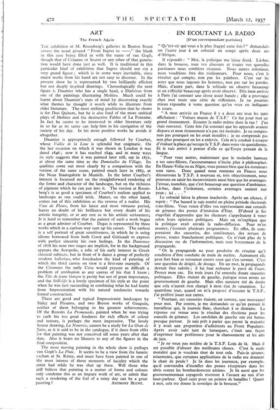ART
The French Again
THE exhibition at M. Rosenberg's galleries in Bruton Street covers the usual ground " From Ingres to —," the blank in this cast being filled in with the name of van Gogh, though that of Cezanne or Seurat or any other of that genera- tion would have done just as well. It is traditional in this particular kind of exhibition that Ingres should not cut a very grand figure ; which is in some ways inevitable, since major works from his hand are not easy to discover. In the present show he is represented by two brilliantly efficient but not deeply inspired drawings. Chronologically the next figure is Daumier who has a single head, a Diafoirus from one of the paintings illustrating Moliere. Much could be learnt about Daumier's state of mind by discovering exactly what themes he thought it worth while to illustrate from older literature. The most striking predilection that he shows is for Don Quixote, but he is also fond of the more satirical plays of Moliere and the destructive Fables of La Fontaine. In fact he seems to be interested in older literature only in so far as its satire can help him in his castigation of the society of his day. In his more positive works he avoids it altogether.
Daumier is appropriately enough followed by Courbet, whose Vallie de la Loue is splendid but enigmatic. On the last occasion on which it was shown in London it was dated 1846 ; now it has reached 1849, and in many ways its style suggests that it was painted later still, say in 185r, at about the same time as the Demoiselles du Village. Its qualities come out most dearly by a comparison with the version of the same scene, painted much later in 1865, at the Neue Staatsgalerie in Munich. In the latter Courbet's interest is focussed not on the straightforward rendering of the forms and character of the landscape, but on the richness of pigment which he can put into it. The version at Rosen- berg's is as good a specimen of Courbet's realism applied to landscape as one could wish. Manet, on the other hand, comes out of this exhibition as the reverse of a realist. His Vase de Fleurs, from his latest and most virtuoso period, leaves no doubt of his brilliance but every doubt of his artistic integrity, or at any rate as to his artistic seriousness; It is hard to remember that the painter of such a work began as a great admirer of Courbet. Degas is represented by three works which in a curious way sum up his career. The earliest is a self portrait of great sensitiveness, in which he is using idioms borrowed from both Corot and Gericault to express with perfect sincerity his own feelings. In the Danseuses of 1878 his next two stages are implicit, for in the background appears the Acropolis, a relic of his early interest in Greek classical subjects, but in front of it dance a group of perfectly modern ballerines, who foreshadow the kind of painting of which the third canvas on view is a first-rate example. Of the Cezarmes the early Usine would present as difficult a problem of attribution as any canvas of his that I know ; the Tete de jeune Garcon is pretty but not of great importance, and the Still-life is a lovely specimen of his style at the point when he was just succeeding in combining what he had learnt from Impressionism with his natural tendencies towards formal construction.
There are good and typical Impressionist landscapes by Sisley and Pissarro, and two Breton works of Gauguin, neither of them belonging to his greatest achievements. Of the Renoirs La Promenade, painted when he was trying to curb his too great fondness for rich effects of colour and texture, is perhaps the most impressive. The lovely Seurat drawing, La Nourrice, cannot be a study for La Gran de Yatte, as it is said .to be in the catalogue, if it dates from 1882 for that painting was not conceived till some years after that date. Also it bears no likeness to any of the figures in the final composition.
The most moving painting in the whole show is perhaps van Gogh's La Pluie. It seems to be a view from the lunatic rsylum at St. Remy, and must have been painted in one of the most intense of those moments of lucidity which the artist had while he was shut up there. Will those who still believe that painting is a matter of forms and colours only condemn this as an impure work of art, or admit that such a rendering of the feel of a rainy day can be a great














































 Previous page
Previous page